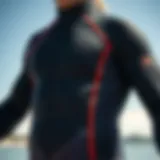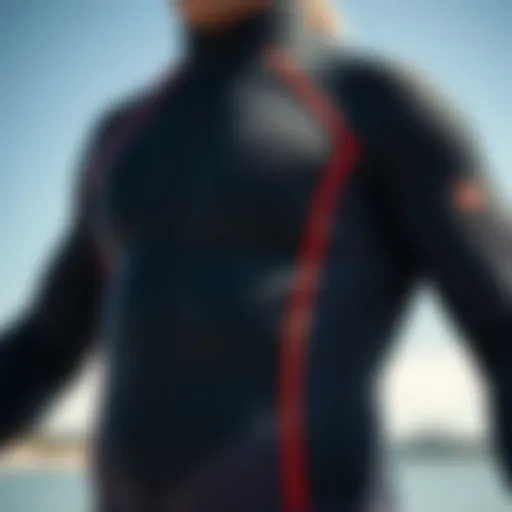Essential Guide to Kiteboard Trainers for All Levels
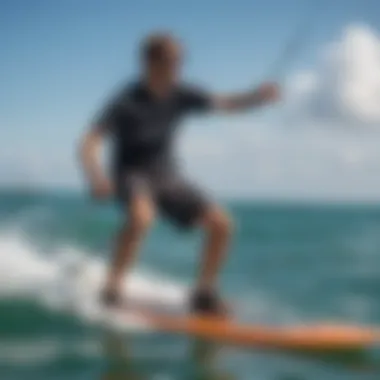

Intro
Kiteboarding is more than just a sport; it’s a dance with the elements, a pursuit that marries skill with adrenaline. For newcomers, the struggle to find stability aboard a board while harnessing the wind can feel like trying to juggle flaming torches. Likewise, seasoned professionals constantly chase the thrill of mastering advanced moves. As kiteboarding continues to grow, kiteboard trainers emerge as crucial tools for anyone looking to up their game.
In this guide, we’ll dissect the inner workings of kiteboard trainers, emphasizing their significant role in two key areas: honing foundational skills for beginners and boosting performance levels for the more experienced riders. Our coverage includes an exploration of different styles, techniques, essential safety guidelines, and the perks of enlisting professional training. Stay with us as we spotlight the most recent trends and innovations in kiteboarding gear, all tailored to elevate the kiteboarding experience.
This comprehensive discourse is crafted for a varied audience including surfers, outdoor enthusiasts, lifestyle bloggers, and athletes, ensuring there's something for everyone seeking to understand the nuances of kiteboarding better.
So, strap in and get ready to navigate through the essential aspects that shape the art of kiteboarding.
Understanding Kiteboarding
Grasping the fundamentals of kiteboarding is crucial for anyone looking to dive into this exhilarating sport. Knowledge not only fosters skill development but also enhances safety and enjoyment. Let's explore why understanding kiteboarding is essential.
The Evolution of Kiteboarding
Kiteboarding, as we know it today, has come a long way since its humble beginnings. Initially, the sport emerged in the late 1970s and early 1980s, with windsurfing enthusiasts toying with kites attached to surfboards. These early prototypes were often clunky and inefficient, but they laid the groundwork for what kiteboarding has become.
As kite technology improved throughout the years, so did the techniques. In the 1990s, the introduction of the inflatable kite proved to be a game changer. Riders could now harness stronger winds without sacrificing control. This fueled an explosion of interest, bringing forth new styles and disciplines. Today, the ocean is filled with kiteboarders zipping around, performing incredible maneuvers that were once thought impossible.
Key Components of Kiteboarding
To become proficient in kiteboarding, understanding its core components is pivotal. Here’s a breakdown of the essential elements:
- Kite: The kite is your primary source of power. Different types serve various conditions and riding styles. The right kite can make all the difference between a smooth sail and a bumpy ride.
- Board: Kitesurfing boards vary in shape, size, and material, influencing performance and stability on the water. Knowing your style can help in selecting the perfect board.
- Harness: A properly fitted harness connects you to the kite, allowing you to transfer load efficiently. Whether opting for a waist or seat harness, comfort is key here.
- Lines: The lines are the lifelines connecting the kite to the rider, playing a vital role in steering and controlling the kite. It’s important to understand the specifications and maintenance of your lines.
Understanding these elements is akin to knowing the ins and outs of any sport; it creates a foundation for building skills. Each component has a role, and familiarity can lead to faster learning and improved performance while kiteboarding.
"Success in kiteboarding isn't just about the thrill; it's about knowledge and safety. Knowing your gear and its intricacies can prevent mishaps and enhance the fun."
Role of a Kiteboard Trainer
When it comes to the journey of kiteboarding, having the right trainer is like having a good compass in the midst of a storm. The role of a kiteboard trainer extends beyond simply teaching a few tricks; it’s about laying the foundation for a safe and enriching water experience. Trainers are vital for beginners who are navigating the waters for the first time and for seasoned riders looking to perfect their skills.
Definition and Purpose
A kiteboard trainer is specifically designed to help individuals learn the ropes of kiteboarding in a controlled and manageable environment. Unlike standard kites used for freestyle or racing, trainer kites are smaller, lighter, and often come with simpler controls. The main objective of these kites is to familiarize riders with essential concepts like power control, steering, and kite handling before they even hit the water. In simpler terms, they help you find your sea legs without a hefty fall into the waves.
Trainer kites serve multiple purposes:
- Safety First: Their smaller size reduces the risk of injury, allowing beginners to learn without feeling overwhelmed.
- Skill Development: They offer a safe playground to work on key skills such as launching, landing, and basic maneuvering.
- Cost-Effectiveness: Investing in a trainer kite is more budget-friendly compared to full-sized kites, which makes it easier to dive into the sport without breaking the bank.
In essence, a kiteboard trainer becomes your first friend in the world of kiteboarding.
How Trainers Facilitate Learning
Trainers help bridge the gap between theory and practice. Through hands-on learning, riders can grasp the nuances of kiteboarding without the immediate pressure of mastering complex techniques. Here’s how they do it:
- Hands-On Experience: With a trainer, learners can practice on land, getting a feel for control and kite movements before heading into the unpredictable expanse of water.
- Incremental Learning: Each session can build upon the last. Beginners can start with basic maneuvers and gradually work their way up to advanced techniques such as jumping or transitioning.
- Understanding Wind Dynamics: Trainers help riders become accustomed to how wind affects kite behavior. Learning this vital skill on land can make all the difference when transitioning to water.
"The true essence of kiteboarding isn’t just about riding the waves; it’s about understanding the wind and becoming one with it."
A well-structured learning path with a trainer not only enhances skills but also boosts confidence. The emotional and mental landscape is just as vital as the physical aspect of kiteboarding. By using trainers as stepping stones, riders move closer to mastering the full experience of kiteboarding, ensuring both enjoyment and safety along their journey.
Choosing the Right Trainer Kite
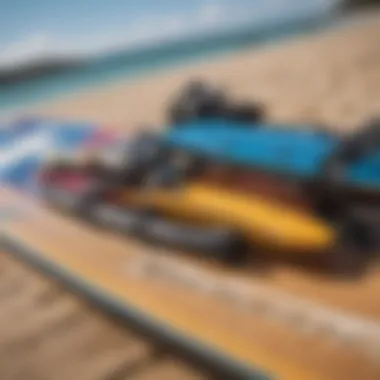

When it comes to kiteboarding, selecting the right trainer kite is pivotal for novices and seasoned riders alike. It could make the difference between zipping through the waves with confidence and feeling lost on the water. Choosing the appropriate trainer kite not only influences your learning curve, but it also affects overall enjoyment. A suitable kite allows you to grasp the basics smoothly, ensuring that every session is fruitful.
Furthermore, a well-chosen trainer kite enhances safety, allowing you to practice skills without unnecessary worries. This section dives into the various types and sizes of trainer kites, equipping you with the knowledge that makes kite-selecting less daunting.
Types of Trainer Kites
Foil Kites
Foil kites are a top pick among many beginners, primarily due to their simple design and performance versatility. Made from soft fabric, these kites have an internal frame that helps them inflate when in use. The primary characteristic that sets foil kites apart is their stability. They offer a gentle pull, making them perfect for those just starting their kiteboarding journey.
Moreover, foil kites are lightweight, which means you can easily carry them to your desired location. They don’t require extra pumps for deflation, making packing up a breeze after a long day on the water. On the downside, they may not perform as well in high-wind conditions compared to other types of kites. Still, for training purposes, their manageable nature often makes them a frontrunner in the trainer kite category.
Leading Edge Inflatable Kites
On the flip side, we have Leading Edge Inflatable (LEI) kites, which are popular for their robust performance capabilities. These kites have a rigid frame that stays inflated, providing a more substantial pull compared to foil kites. Riders often appreciate the explosive jumps and greater stability in various wind conditions that LEIs offer.
However, their unique feature—requiring pumps to inflate—can be a bit of a hassle for those just starting. Setting them up might take slightly longer than foil kites, but the trade-off often pays off when it comes to performance. For those looking to progress quickly in kiteboarding, LEIs could represent an invaluable investment.
Sizing Considerations
Selecting the right size trainer kite is another crucial aspect. Size affects not just how the kite handles but also the overall fun factor. A larger kite generally provides more lift and power, making it ideal in lighter winds. Conversely, a smaller kite is easier to control, especially for beginners who are still getting a hang of things.
It's wise to think about your weight and wind conditions when sizing up your trainer kite. In lighter winds, you might favor a larger kite, while in stronger winds, a smaller, more nimble kite might be the way to go. Understanding these concepts ensures a smoother, safer learning process as you navigate through your kiteboarding journey.
Training Techniques
When it comes to mastering the art of kiteboarding, the significance of training techniques cannot be overstated. These techniques not only help beginners to find their footing but also play a vital role in refining the skills of more experienced riders. Learning to maneuver a kite, control the board, and adapt to various conditions are all fundamental components that shape a successful kiteboarding journey. Moreover, the proper training techniques lay the groundwork for a safe and enjoyable experience on the water.
Both beginners and seasoned riders benefit from a systematic approach to training. This isn’t just about catching some wind and riding; it's about developing muscle memory and understanding the dynamics at play, as well as how to respond to sudden changes in weather or water conditions. The best part? With the right training techniques, riders can significantly shorten their learning curve while enhancing their overall performance.
Basic Maneuvers
Mastering the basics is the first step for anyone new to kiteboarding. Familiarity with fundamental maneuvers equips riders with the necessary skill set to control the kite and board effectively. Here are a few essential maneuvers to focus on:
- Power Stroke: This is the heart of kite control. Through proper power strokes, riders learn how to generate lift and speed by guiding the kite through the power zone.
- Body Dragging: This maneuver teaches new riders how to stay afloat and recover the board if they happen to wipe out. It involves using the kite to pull yourself through the water, maintaining control without a board.
- Water Starts: Getting up on the board from the water is a critical skill. Understanding how to position the kite and body is crucial to achieving a smooth water start.
As riders practice these maneuvers, they develop a better understanding of how the kite interacts with water and wind. This understanding is pivotal when it comes to making adjustments on the fly, which can make or break a rider's session.
Advanced Techniques
For those who have honed their basic skills, diving into advanced techniques can open up a new realm of possibilities. These techniques not only enhance performance but also bring excitement into kiteboarding. Here’s a look at some advanced maneuvers that every serious kiteboarder should consider:
- Jumping: Learning to jump successfully takes practice and precision. Riders need to master timing the lift from the kite with the right amount of edge from the board.
- Transitions: These are sharp turns where riders switch direction while maintaining speed. It’s a dance of finesse, showcasing control and skill.
- Tricks and Stunts: Once comfortable with the basics and jumps, riders can start to add flips, spins, and grabs to their repertoire, pushing personal limits and creativity.
Each advanced maneuver builds upon the foundation set by the basics. More importantly, they can distinguish one rider from another, bringing unique flair to their kiteboarding style.
"The ability to adapt and evolve your skills is what separates a good kiteboarder from a great one."
As kiteboarding continues to evolve, so do the techniques associated with it. Staying updated through lessons or community engagement can ensure that riders embrace the latest methods, enhancing their capabilities on the water.
Safety Precautions
When venturing into the world of kiteboarding, safety should always occupy the frontline of your mind. The thrill of maneuvering a kite through winds can be intoxicating, but without proper precautions, the risks can far outweigh the rewards. Kiteboarding isn't just about enjoying the rush; it’s about knowing how to navigate the elements and ensuring that every potential hazard is mitigated.
Understanding Wind Conditions
Knowing the wind conditions can make or break a kiteboarding experience. Not all winds are created equal; they can shift unexpectedly. Winds affect not only how your kite behaves but also how you manage your board. It’s crucial to learn how to read the wind effectively. Here are some pointers to consider:
- Wind Speed and Direction: Begin with checking the wind's speed. Ideally, beginners should stick to lighter winds, around 10-15 knots. It’s also key to understand the wind direction relative to your intended launch site. Watch for any signs, like flags or trees, to gauge consistent wind patterns.
- Understanding Gusts: Gusts can be sudden spikes in wind speed that catch you off guard. Familiarize yourself with how to spot a gusty area and avoid it, especially if you’re a novice.
- Local Knowledge: Engage with local kiteboarding communities or forums. Websites like reddit.com can provide insights on unpredictable wind behaviors in certain spots.
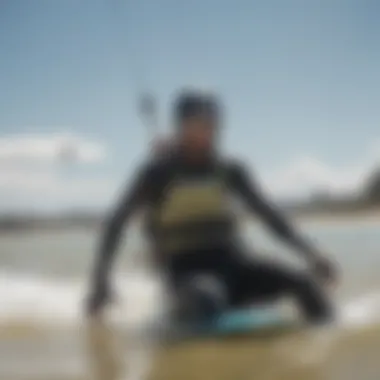

"The wind is not only a friend; it can turn into a foe if you don’t respect its whims."
Gear Safety Checks
Ensuring that your gear is in tip-top shape is part and parcel of enjoying a safe kiteboarding experience. Before hitting the waves, performing a detailed equipment check can save you from potential dilemmas out on the water. Here’s a rundown of what to inspect:
- Kite Integrity: Check your kite for any punctures or tears. A compromised kite can lead to disastrous consequences when in full flight.
- Lines and Connections: Inspect the lines for any frays or tangles. Even minor issues here can lead to major problems when you’re out in the ocean. Ensure that all connections are secure.
- Harness and Safety Leash: Your harness should fit snugly, but comfortably. Your safety leash is your lifeline; ensure it functions reliably and is attached properly to your kite.
Safety isn't just a guideline; it's an obligation when you're out kiteboarding. By understanding the wind conditions and performing thorough gear checks, you’ll ensure that your focus is on honing your skills rather than dodging preventable problems.
The Importance of Professional Instruction
When it comes to kiteboarding, honing your skills under the guidance of a seasoned instructor can be the difference between soaring high and crashing hard. Many novices dive in with enthusiasm, eager to experience the thrill of riding the waves. However, the truth is that navigating the complexities of kiteboarding requires more than just passion; it involves a deep understanding of both equipment and environment. Professional instruction provides that essential foundation.
Choosing to take lessons can dramatically expedite the learning process. Instead of spending countless hours wrestling with a kite and battling the wind, a qualified instructor offers tailored guidance, sharpening your abilities in a fraction of the time. With expert oversight, you're less likely to develop bad habits that can be tough to shake later on. The key is to get started on the right foot from the get-go.
"Learning kiteboarding without proper instruction is like trying to build a house without a blueprint. You might end up somewhere, but it likely won't be where you intended."
Advantages of Taking Lessons
Opting for professional lessons comes with a variety of benefits that can shape your kiteboarding journey:
- Structured Learning: Instructors utilize proven teaching methodologies, breaking down complex techniques into simple, digestible parts.
- Immediate Feedback: Real-time corrections can significantly enhance your skill progression, ensuring that you adjust your techniques before they become ingrained.
- Safety First: With an expert, you learn essential safety protocols and how to respond to unexpected situations, which is crucial for enjoyment and survival on the water.
- Enhanced Confidence: Starting out can feel overwhelming. A professional trainer helps build not just skills but also confidence, allowing you to tackle challenges with poise.
These advantages together help establish a solid groundwork for all kiteboarders, lifting the level of enjoyment and safety for both novices and experienced riders.
Selecting a Qualified Instructor
Finding the right instructor isn't just about picking the first name in the directory. This choice can significantly impact your journey on the water. Here are some factors to consider:
- Credentials and Experience: Seek instructors who are certified by recognized kiteboarding organizations. Their background and experience level can inform you about their expertise.
- Teaching Style: Everyone learns differently. Some instructors have a strict approach, while others are more relaxed. Observe or ask about their teaching philosophy to ensure it aligns with your learning preferences.
- Reputation: A quick glance at reviews or testimonials can go a long way. Recommendations from fellow kiteboarders can often point you in the right direction.
- Safety Focused: An instructor should place a premium on safety, understanding how to teach not only the fun side of kiteboarding but also how to handle risks effectively.
In sum, professional instruction is not merely an add-on; it's an integral part of the kiteboarding experience that can enhance both skill acquisition and safety management. For anyone serious about kiteboarding, partnering with the right instructor could set you on a thrilling yet secure path in this exhilarating sport.
Gear and Equipment for Kiteboarding
When it comes to kiteboarding, the right gear can make or break your experience on the water. It is the backbone of both safety and performance, establishing a solid foundation for beginners and offering advanced riders the tools they need to push their limits. Understanding the nuances of gear will not only enhance your enjoyment but ensure you’re well-prepared for the challenges that lie ahead.
Essential Gear for Beginners
Every novice kiteboarder must start with the basics. Here’s what you need:
- Kite: Your choice of kite greatly influences how you learn. A trainer kite works wonders for newbies, allowing for smooth takeoffs and landings. The size varies, but generally, a smaller kite is more manageable. As you grow, jumping to something larger can improve your performance.
- Control Bar: This device offers perfect control over your kite. It allows you to steer and manage the power generated by the kite. Beginners should look for a bar that feels comfortable and intuitive. Racing against the wind is much smoother when you can rely on solid grips.
- Harness: A harness may seem like a secondary piece of kit, but it doesn’t deserve to be overlooked. It takes the strain off your arms and distributes the force across your body, crucial for any extended session on water. Look for a waist or seat harness that fits snugly, yet comfortable.
- Board: Picking the right board is imperative. For beginners, wider boards tend to offer more stability. When you’re just starting out, you might prefer a board that has a softer flex, which helps absorb the impact of choppy water.
- Safety Gear: Safety shouldn’t be left to chance. Therefore, investing in a helmet and a personal flotation device is wise. They not only offer protection but can provide peace of mind while you're discovering the thrill of kiteboarding.
"The right gear isn't just about performance; it's about feeling safe and confident in your skillset as you carve through the waves."
Upgrading for Performance
Once you’ve mastered the basics, you might find yourself ready to upgrade your gear. The step-up can drastically enhance your kiteboarding experience:
- Performance Kites: After finding your footing and feeling comfortable, invest in performance kites. These are generally designed for advanced riders and provide better control, faster turning, and increased lift for jumping.
- Higher-End Boards: A performance board crafted from advanced materials, like carbon fiber or lightweight woods, can significantly improve speed and responsiveness. These boards often feature a better design that caters to your specific riding style.
- Control Bar Upgrades: As your skills evolve, consider a bar that offers customization. Some advanced bars come with adjustable features to control the power and aspects of the kite's performance tailored to weather conditions.
- Bindings: Upgrading your foot bindings also makes a difference. Fitted bindings provide better control and responsiveness, enhancing your ability to perform tricks as you advance.
In kiteboarding, gear is more than just equipment. It’s an extension of your skill level and a way to express your style on the water. Whether you’re just starting or looking to move up the ranks, the right equipment has a role in your learning journey and your ultimate performance.
Kiteboarding Locations and Conditions
The world of kiteboarding isn't just about the skill of riding; it also pivots heavily around where you choose to practice and play. The right kiteboarding location can make or break your experience, affecting not only your learning curve but also your enjoyment of this exhilarating sport. Let's dive deeper into what to look for and why it matters.
Choosing the Right Spot
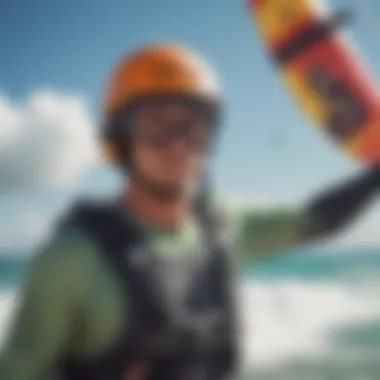

Selecting a kiteboarding spot is akin to picking the right stretch of road for a leisurely drive. You wouldn’t want to be surrounded by distractions or dangers, would you? When contemplating an ideal location, consider factors such as wind consistency, accessibility, and local regulations.
- Wind Conditions: Ideally, you want a place that offers steady winds, typically between 12 to 25 knots for beginners. Wind direction also plays a role - offshore winds can be dangerous for novices while onshore winds provide a comforting cushion of safety.
- Access and Launch Areas: Check if the area has designated launch spaces and is accessible by vehicle. Beaches with easy entry points are primes spots for novice kiteboarders.
- Crowd Levels: If you’re still honing your skills, it might be best to avoid spots that are notoriously crowded. Other kiters can create hazards, especially if you’re still learning basic controls.
In some regions, there are kiteboarding communities online where you can ask for recommendations. Check out forums on platforms like Reddit or Facebook for locals’ insights.
Evaluating Water Conditions
Water conditions play a crucial part in ensuring your safety and progression in kiteboarding. Think about it - choppy waters can churn your confidence faster than a blender. So, let’s break down the elements you need to assess before hitting the waves.
- Water Type: Are you dealing with flat water, waves, or a mix of both?
- Obstacles: Look for hidden rocks, lines, or sandbars that could ruin your day. Clear areas are preferred, particularly for beginners who are still mastering their turns.
- Tides: Understanding how the tides work can vastly change your kiteboarding experience. High tides can offer deeper water, but they also might bring currents that can sweep you away. Access tide charts to plan your sessions accordingly.
- Flat water is ideally suited for beginners as it allows for easier starting and better board control.
- Waves can provide a thrilling challenge, but they are better left for experienced riders who know how to handle themselves.
Pro Tip: Always check local guidance on water conditions, as they can shift considerably due to weather changes.
By grasping these location and water factors, you’ll position yourself for a safer and much more enjoyable kiteboarding journey. Professional instructors in your area can often provide recommendations tailored to your skill level, making your search for the perfect spot simpler.
Community and Culture in Kiteboarding
Kiteboarding isn't just an adrenaline-fueled sport; it's a vibrant community that brings together enthusiasts from all walks of life. This connection among riders can turn the solitary act of gliding across the water into a shared journey, enriching the experience leagues beyond individual prowess. In this section, we’ll explore why this culture is vital and how interlinking with fellow kiteboarders enhances the overall journey.
Connecting with Other Enthusiasts
Engaging with fellow kiteboarding aficionados can be a game changer. No matter whether you're a budding rider still finding your footing or a seasoned wave chaser, connecting with others helps forge bonds that deepen your appreciation for the sport. Here are some key aspects of how these connections can benefit you:
- Shared Knowledge: Experience speaks volumes, and there's much to learn by chatting with more experienced riders. They can offer insights on techniques and gear that can be invaluable for your own growth.
- Social Events: Regular gatherings, whether they’re informal beach cookouts or organized training sessions, create an ambiance of camaraderie. Learning alongside others fosters motivation and makes the learning experience much more enjoyable.
- Support Network: It’s not just about skills; kiteboarding can be a perilous venture too. Knowing there’s a network of like-minded enthusiasts can provide necessary support and tips when dealing with challenging conditions or gear issues.
"Kiteboarding isn’t just riding the wind; it’s about riding the waves of friendship that come with it."
Recognizing the significance of connecting with others can transform your kiteboarding experience from a solo venture to a shared adventure.
Participating in Events
Creating a sense of belonging in the kiteboarding sphere can often be amplified through active participation in events. These gatherings range from local competitions to international festivals, and each offers unique opportunities. Here are a few reasons why getting involved serves you well:
- Skill Development: Many events include workshops or tutorials led by seasoned professionals where you can refine techniques or learn something entirely new. They often cater to various skill levels, ensuring everyone gains something.
- Networking Opportunities: Kiteboarding events are a melting pot for connecting with industry specialists, potential sponsors, and fellow enthusiasts. Building relationships in these environments might lead to opportunities you wouldn’t come across otherwise.
- Community Bonding: The vibe at these events is electric. You'll quickly realize that the energy of shared passion can foster lasting friendships and lead to future collaboration.
Through such activities, your passion for kiteboarding can evolve beyond just a pastime. It becomes part of a larger movement, ingraining a sense of pride and ownership in the kiteboarding community.
Future Trends in Kiteboarding
In the fast-evolving world of kiteboarding, staying abreast of the latest trends can be the key to both safety and performance. The trends shape how enthusiasts approach the sport, influencing everything from the design of equipment to the choice of training methodologies. Understanding these future trends not only enhances the riding experience but also promotes sustainability and innovation, making them crucial for every kiteboarding aficionado.
Innovations in Equipment
The equipment for kiteboarding has come a long way from its early iterations. One of the standout trends is the shift towards lighter and more durable materials. Modern kites utilize advanced fabrics that can withstand harsher conditions while being easier to maneuver.
- Smart Kites: One remarkable innovation is the advent of smart kites. These kites can adjust automatically to changing wind conditions, enhancing safety and control for riders. The incorporation of sensors allows the kites to communicate data back to the rider's smartphone, providing insights into performance that were previously unattainable.
- Inflatable Tech: The development of leading-edge inflatable kites has also made a remarkable impact. Known for their stability and ease of use, they have become favorites among both beginners and experienced riders.
- Modular Designs: Another trend is the modular construction of kiteboards, allowing riders to customize their setup more easily. This personalization not only improves performance but also caters to individual riding styles and preferences, fostering a closer connection between the athlete and their gear.
The importance of these innovations can't be overstated – they ensure that riders are better equipped to tackle diverse environments and challenging winds.
Environmental Considerations
Modern kiteboarding isn’t just about embracing the thrill; it’s increasingly tied to environmental stewardship. As awareness of ecological issues grows, the kiteboarding community is stepping up. Here are some key considerations that the community is focusing on:
- Sustainable Materials: Gear manufacturers are making concerted efforts to replace traditional materials with more sustainable options. For instance, some brands are experimenting with biodegradable materials for their kites, designed to lessen the environmental impact of gear disposal.
- Eco-Friendly Practices: Events and communities are promoting eco-friendly practices. Clean-up drives at popular spots and education about preserving marine environments have become common, creating a culture that values environmental responsibility alongside the sport itself.
- Carbon Offsetting Initiatives: Many kiteboarding companies are adopting carbon offset programs. By investing in renewable energy projects or tree planting, they counterbalance their environmental footprint, helping to ensure that kiteboarding remains sustainable in the long run.
As kiteboarding continues to gain traction around the globe, these discussions around sustainability will likely shape future developments and practices in the sport. By addressing environmental challenges, the kiteboarding community encourages not only thrilling performances but also a thriving ecosystem for future generations.
"In kiteboarding, innovation isn't just about the adventure; it's about leaving a light footprint as we soar across the waves."
In summary, future trends in kiteboarding reflect a blend of performance enhancement and environmental consciousness. As kites grow smarter and practices shift towards sustainability, kiteboarding is looking not just to the skies but also to the world beneath the waves, ensuring a balance between thrill and responsibility.
